Target Information
| Target General Information | Top | |||||
|---|---|---|---|---|---|---|
| Target ID |
T70851
(Former ID: TTDI03378)
|
|||||
| Target Name |
Extracellular signal-regulated kinase 5 (ERK5)
|
|||||
| Synonyms |
PRKM7; Mitogen-activated protein kinase 7; MAPK 7; MAP kinase 7; ERK-5; Big MAP kinase 1; BMK1; BMK-1
Click to Show/Hide
|
|||||
| Gene Name |
MAPK7
|
|||||
| Target Type |
Patented-recorded target
|
[1] | ||||
| Function |
The upstream activator of MAPK7 is the MAPK kinase MAP2K5. Upon activation, it translocates to the nucleus and phosphorylates various downstream targets including MEF2C. EGF activates MAPK7 through a Ras-independent and MAP2K5-dependent pathway. May have a role in muscle cell differentiation. May be important for endothelial function and maintenance of blood vessel integrity. MAP2K5 and MAPK7 interact specifically with one another and not with MEK1/ERK1 or MEK2/ERK2 pathways. Phosphorylates SGK1 at Ser-78 and this is required for growth factor-induced cell cycle progression. Involved in the regulation of p53/TP53 by disrupting the PML-MDM2 interaction. Plays a role in various cellular processes such as proliferation, differentiation and cell survival.
Click to Show/Hide
|
|||||
| BioChemical Class |
Kinase
|
|||||
| UniProt ID | ||||||
| EC Number |
EC 2.7.11.24
|
|||||
| Sequence |
MAEPLKEEDGEDGSAEPPGPVKAEPAHTAASVAAKNLALLKARSFDVTFDVGDEYEIIET
IGNGAYGVVSSARRRLTGQQVAIKKIPNAFDVVTNAKRTLRELKILKHFKHDNIIAIKDI LRPTVPYGEFKSVYVVLDLMESDLHQIIHSSQPLTLEHVRYFLYQLLRGLKYMHSAQVIH RDLKPSNLLVNENCELKIGDFGMARGLCTSPAEHQYFMTEYVATRWYRAPELMLSLHEYT QAIDLWSVGCIFGEMLARRQLFPGKNYVHQLQLIMMVLGTPSPAVIQAVGAERVRAYIQS LPPRQPVPWETVYPGADRQALSLLGRMLRFEPSARISAAAALRHPFLAKYHDPDDEPDCA PPFDFAFDREALTRERIKEAIVAEIEDFHARREGIRQQIRFQPSLQPVASEPGCPDVEMP SPWAPSGDCAMESPPPAPPPCPGPAPDTIDLTLQPPPPVSEPAPPKKDGAISDNTKAALK AALLKSLRSRLRDGPSAPLEAPEPRKPVTAQERQREREEKRRRRQERAKEREKRRQERER KERGAGASGGPSTDPLAGLVLSDNDRSLLERWTRMARPAAPALTSVPAPAPAPTPTPTPV QPTSPPPGPVAQPTGPQPQSAGSTSGPVPQPACPPPGPAPHPTGPPGPIPVPAPPQIATS TSLLAAQSLVPPPGLPGSSTPGVLPYFPPGLPPPDAGGAPQSSMSESPDVNLVTQQLSKS QVEDPLPPVFSGTPKGSGAGYGVGFDLEEFLNQSFDMGVADGPQDGQADSASLSASLLAD WLEGHGMNPADIESLQREIQMDSPMLLADLPDLQDP Click to Show/Hide
|
|||||
| 3D Structure | Click to Show 3D Structure of This Target | AlphaFold | ||||
| HIT2.0 ID | T87O4D | |||||
| Cell-based Target Expression Variations | Top | |||||
|---|---|---|---|---|---|---|
| Cell-based Target Expression Variations | ||||||
| Drug Binding Sites of Target | Top | |||||
|---|---|---|---|---|---|---|
| Ligand Name: AMP-PNP | Ligand Info | |||||
| Structure Description | Crystal structure of the ERK5 kinase domain in complex with an MKK5 binding fragment | PDB:4IC7 | ||||
| Method | X-ray diffraction | Resolution | 2.60 Å | Mutation | No | [3] |
| PDB Sequence |
DVTFDVGDEY
55 EIIETIGNGA65 YGVVSSARRR75 LTGQQVAIKK85 IPNAFDVVTN95 AKRTLRELKI 105 LKHFKHDNII115 AIKDILRPTV125 PYGEFKSVYV135 VLDLMESDLH145 QIIHSSQPLT 155 LEHVRYFLYQ165 LLRGLKYMHS175 AQVIHRDLKP185 SNLLVNENCE195 LKIGDFGMAR 205 GLCTSPAEHQ215 YFMTEYVATR225 WYRAPELMLS235 LHEYTQAIDL245 WSVGCIFGEM 255 LARRQLFPGK265 NYVHQLQLIM275 MVLGTPSPAV285 IQAVGAERVR295 AYIQSLPPRQ 305 PVPWETVYPG315 ADRQALSLLG325 RMLRFEPSAR335 ISAAAALRHP345 FLAKYHDPDD 355 EPDCAPPFDF365 AFDREALTRE375 RIKEAIVAEI385 EDFHARREGI395 RQQIR |
|||||
|
|
ILE61
3.857
GLY62
3.211
ASN63
3.812
GLY64
3.882
ALA65
2.757
TYR66
3.521
GLY67
4.530
VAL69
3.452
ALA82
3.670
LYS84
2.706
ARG98
3.140
|
|||||
| Ligand Name: XMD8-92 | Ligand Info | |||||
| Structure Description | ERK5 IN COMPLEX WITH SMALL MOLECULE | PDB:5BYY | ||||
| Method | X-ray diffraction | Resolution | 2.79 Å | Mutation | No | [4] |
| PDB Sequence |
FDVGDEYEII
58 ETIGNGAYGV68 VSSARRRLTG78 QQVAIKKIPN88 AFDVVTNAKR98 TLRELKILKH 108 FKHDNIIAIK118 DILRPTVPYG128 EFKSVYVVLD138 LMESDLHQII148 HSSQPLTLEH 158 VRYFLYQLLR168 GLKYMHSAQV178 IHRDLKPSNL188 LVNENCELKI198 GDFGMARGLY 216 FMTEYVATRW226 YRAPELMLSL236 HEYTQAIDLW246 SVGCIFGEML256 ARRQLFPGKN 266 YVHQLQLIMM276 VLGTPSPAVI286 QAVGAERVRA296 YIQSLPPRQP306 VPWETVYPGA 316 DRQALSLLGR326 MLRFEPSARI336 SAAAALRHPF346 LAKYHDPDDE356 PDCAPPFDFA 366 FDREALTRER376 IKEAIVAEIE386 DFHARREG
|
|||||
|
|
||||||
| Click to View More Binding Site Information of This Target with Different Ligands | ||||||
| Different Human System Profiles of Target | Top |
|---|---|
|
Human Similarity Proteins
of target is determined by comparing the sequence similarity of all human proteins with the target based on BLAST. The similarity proteins for a target are defined as the proteins with E-value < 0.005 and outside the protein families of the target.
A target that has fewer human similarity proteins outside its family is commonly regarded to possess a greater capacity to avoid undesired interactions and thus increase the possibility of finding successful drugs
(Brief Bioinform, 21: 649-662, 2020).
Human Tissue Distribution
of target is determined from a proteomics study that quantified more than 12,000 genes across 32 normal human tissues. Tissue Specificity (TS) score was used to define the enrichment of target across tissues.
The distribution of targets among different tissues or organs need to be taken into consideration when assessing the target druggability, as it is generally accepted that the wider the target distribution, the greater the concern over potential adverse effects
(Nat Rev Drug Discov, 20: 64-81, 2021).
Human Pathway Affiliation
of target is determined by the life-essential pathways provided on KEGG database. The target-affiliated pathways were defined based on the following two criteria (a) the pathways of the studied target should be life-essential for both healthy individuals and patients, and (b) the studied target should occupy an upstream position in the pathways and therefore had the ability to regulate biological function.
Targets involved in a fewer pathways have greater likelihood to be successfully developed, while those associated with more human pathways increase the chance of undesirable interferences with other human processes
(Pharmacol Rev, 58: 259-279, 2006).
Biological Network Descriptors
of target is determined based on a human protein-protein interactions (PPI) network consisting of 9,309 proteins and 52,713 PPIs, which were with a high confidence score of ≥ 0.95 collected from STRING database.
The network properties of targets based on protein-protein interactions (PPIs) have been widely adopted for the assessment of target’s druggability. Proteins with high node degree tend to have a high impact on network function through multiple interactions, while proteins with high betweenness centrality are regarded to be central for communication in interaction networks and regulate the flow of signaling information
(Front Pharmacol, 9, 1245, 2018;
Curr Opin Struct Biol. 44:134-142, 2017).
Human Similarity Proteins
Human Tissue Distribution
Human Pathway Affiliation
Biological Network Descriptors
|
|
|
Note:
If a protein has TS (tissue specficity) scores at least in one tissue >= 2.5, this protein is called tissue-enriched (including tissue-enriched-but-not-specific and tissue-specific). In the plots, the vertical lines are at thresholds 2.5 and 4.
|
| KEGG Pathway | Pathway ID | Affiliated Target | Pathway Map |
|---|---|---|---|
| MAPK signaling pathway | hsa04010 | Affiliated Target |
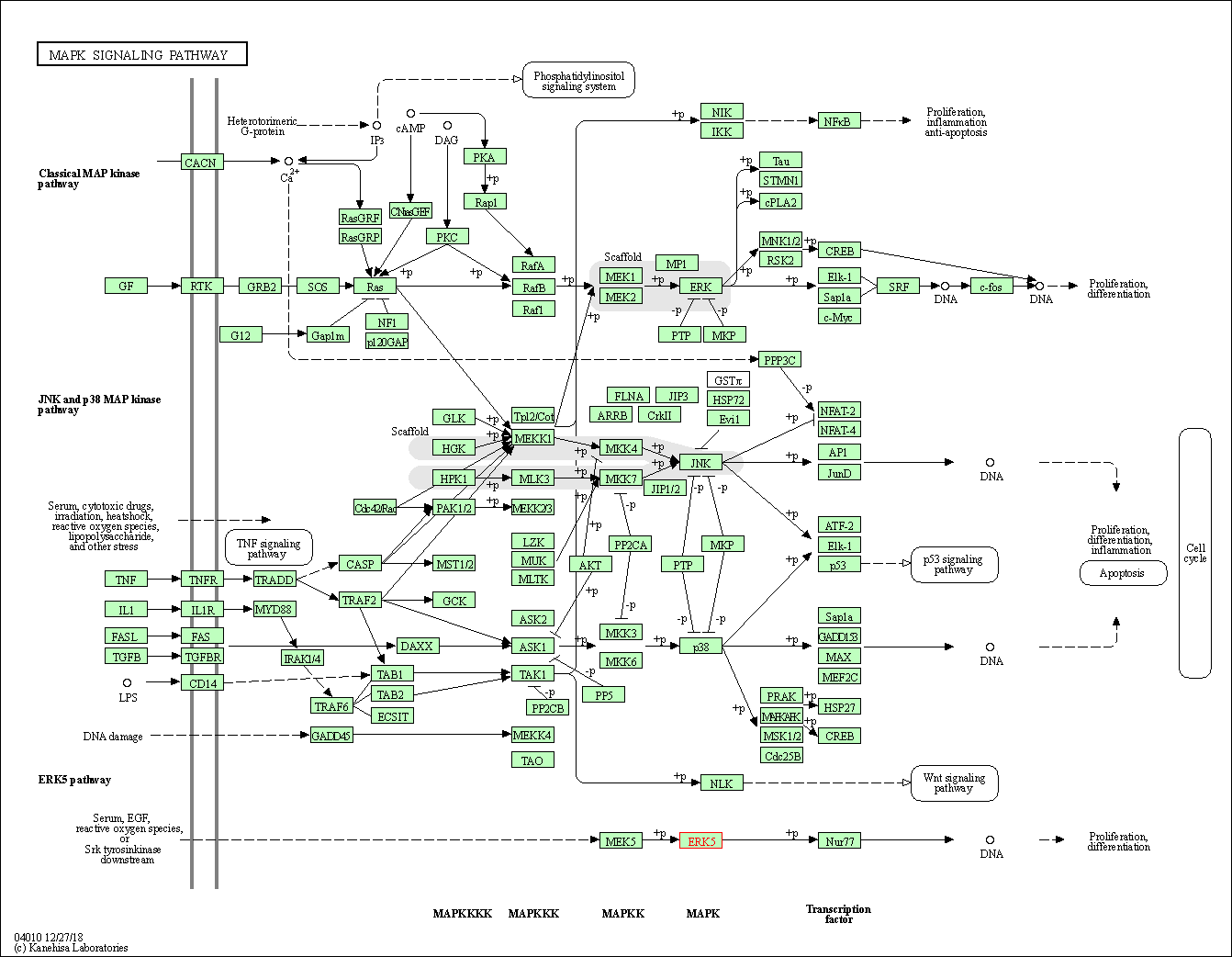
|
| Class: Environmental Information Processing => Signal transduction | Pathway Hierarchy | ||
| Gap junction | hsa04540 | Affiliated Target |
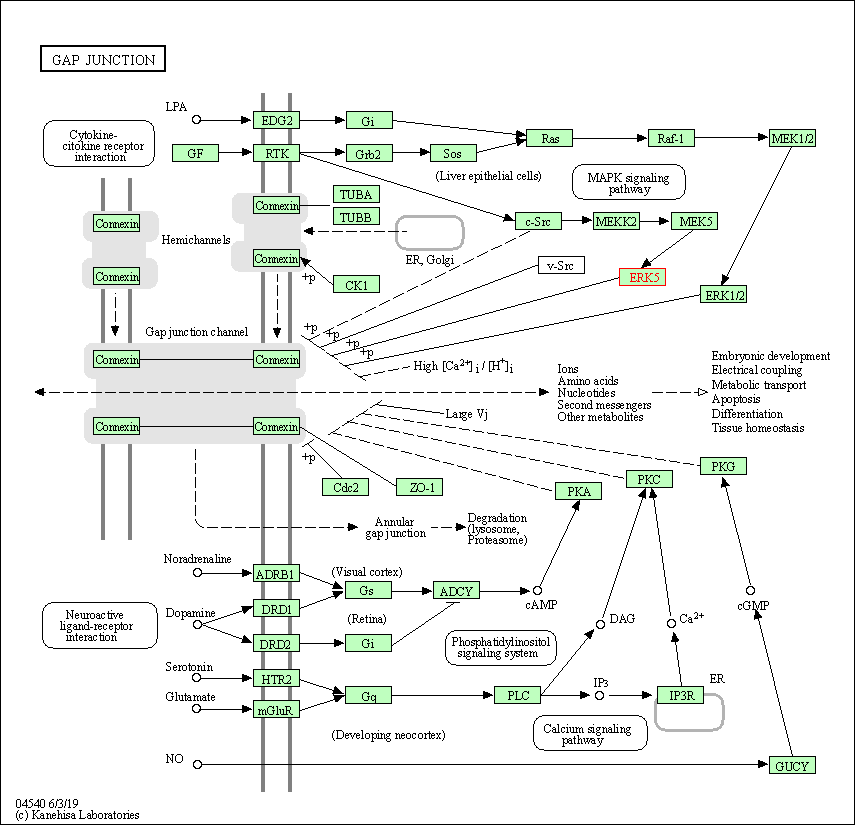
|
| Class: Cellular Processes => Cellular community - eukaryotes | Pathway Hierarchy | ||
| IL-17 signaling pathway | hsa04657 | Affiliated Target |
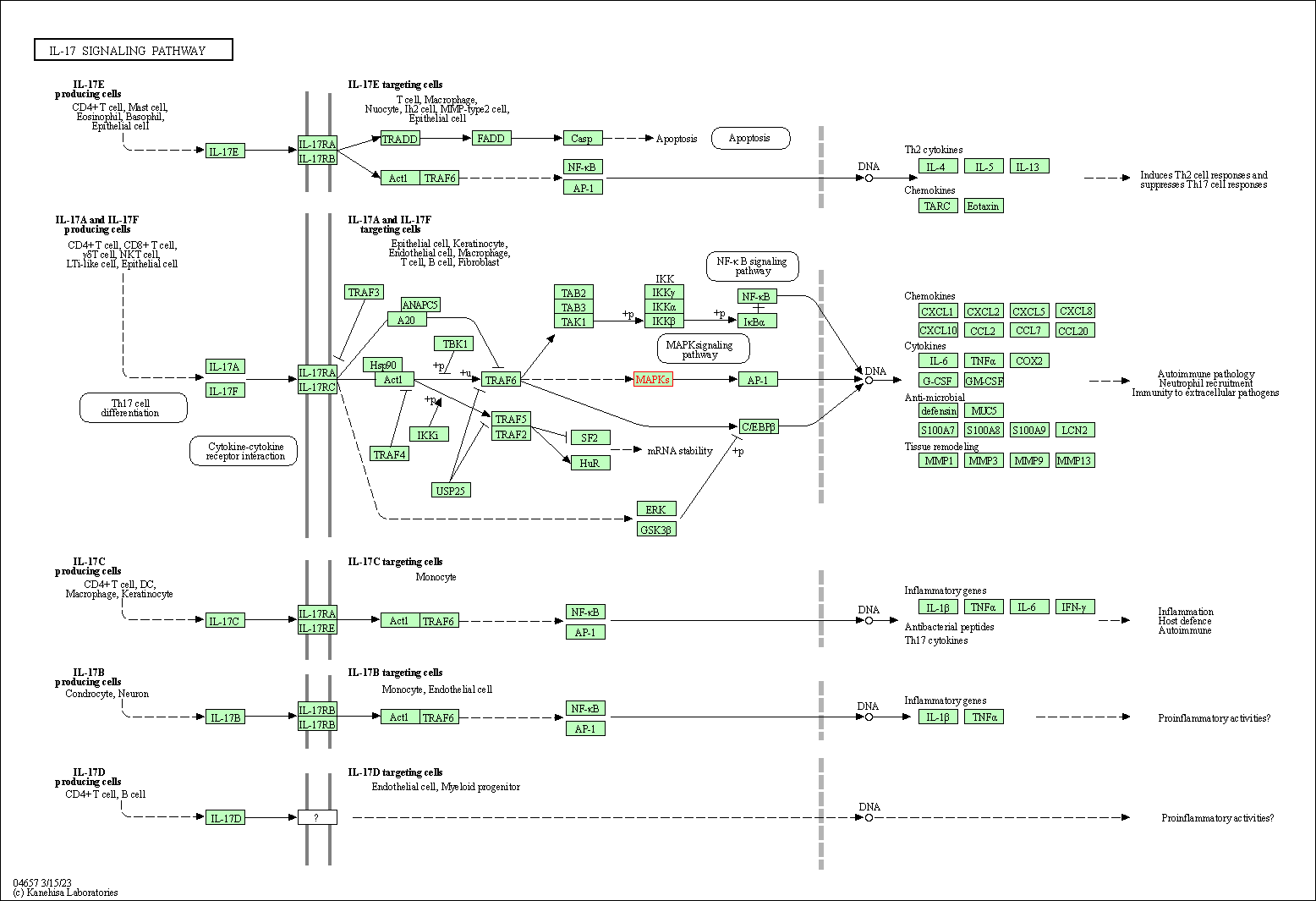
|
| Class: Organismal Systems => Immune system | Pathway Hierarchy | ||
| Neurotrophin signaling pathway | hsa04722 | Affiliated Target |
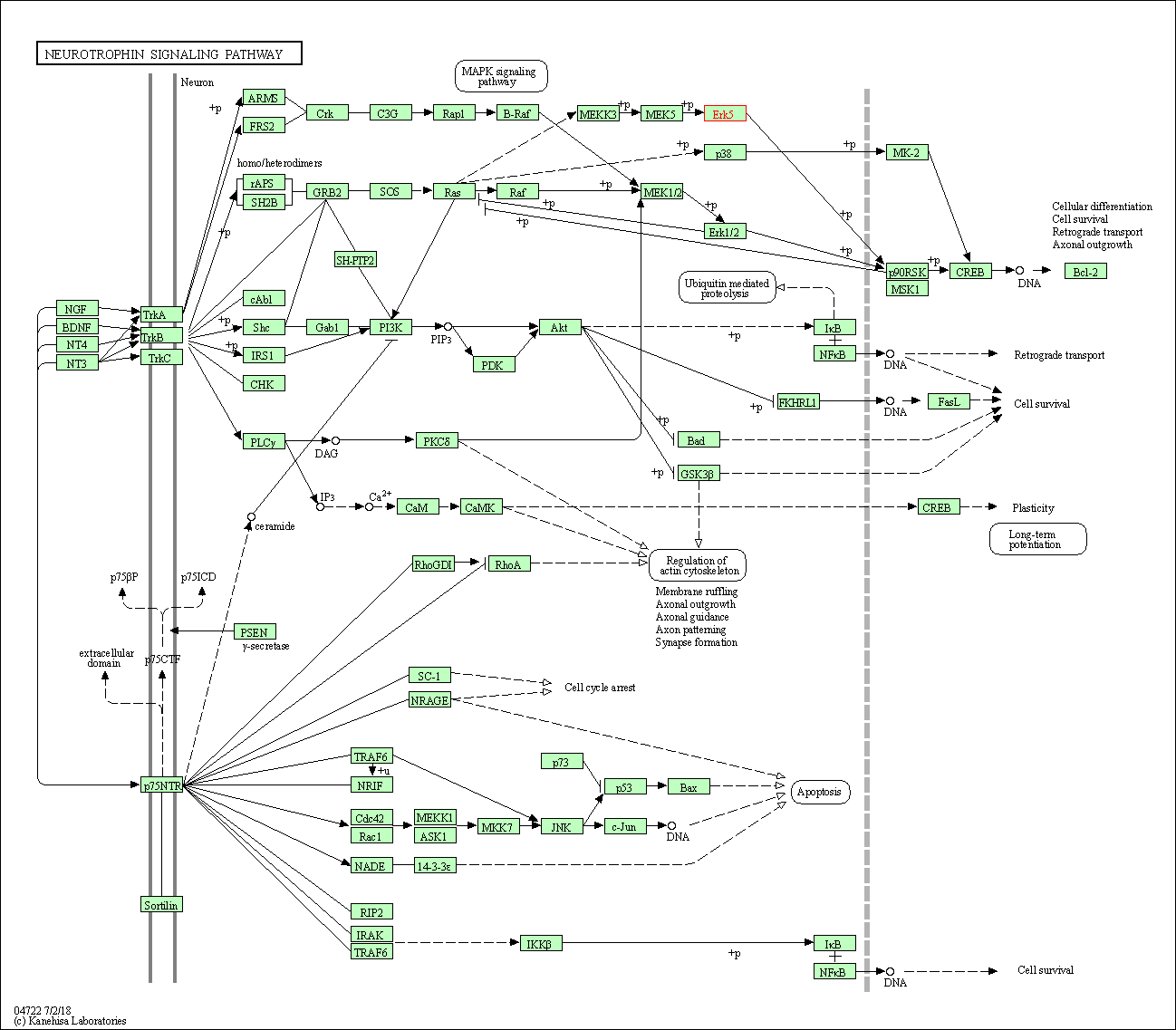
|
| Class: Organismal Systems => Nervous system | Pathway Hierarchy | ||
| GnRH signaling pathway | hsa04912 | Affiliated Target |
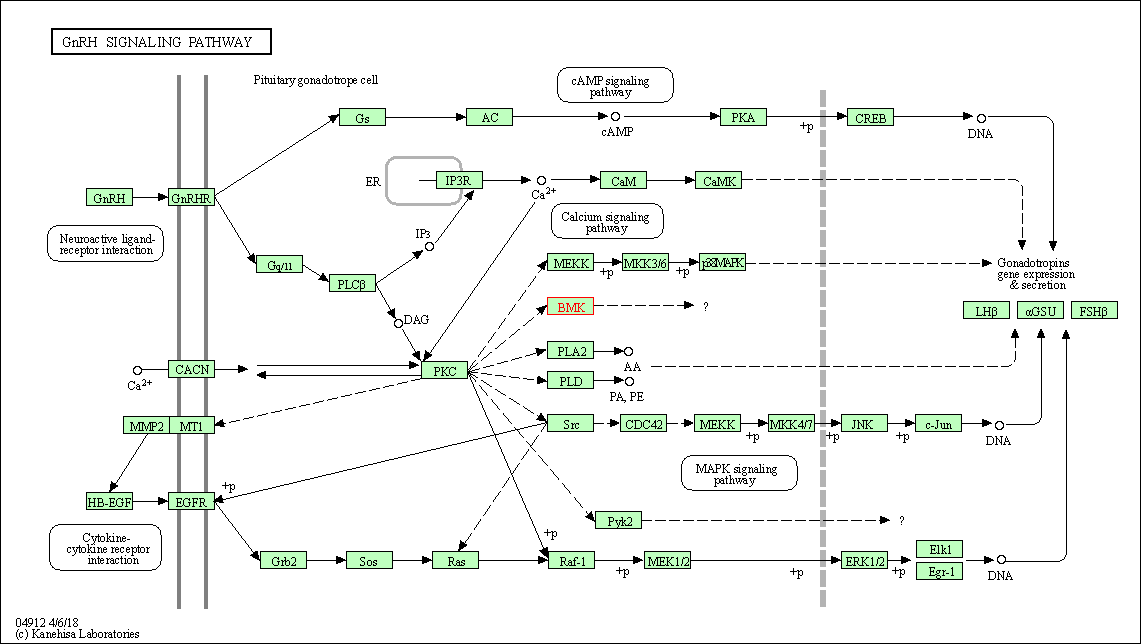
|
| Class: Organismal Systems => Endocrine system | Pathway Hierarchy | ||
| Oxytocin signaling pathway | hsa04921 | Affiliated Target |
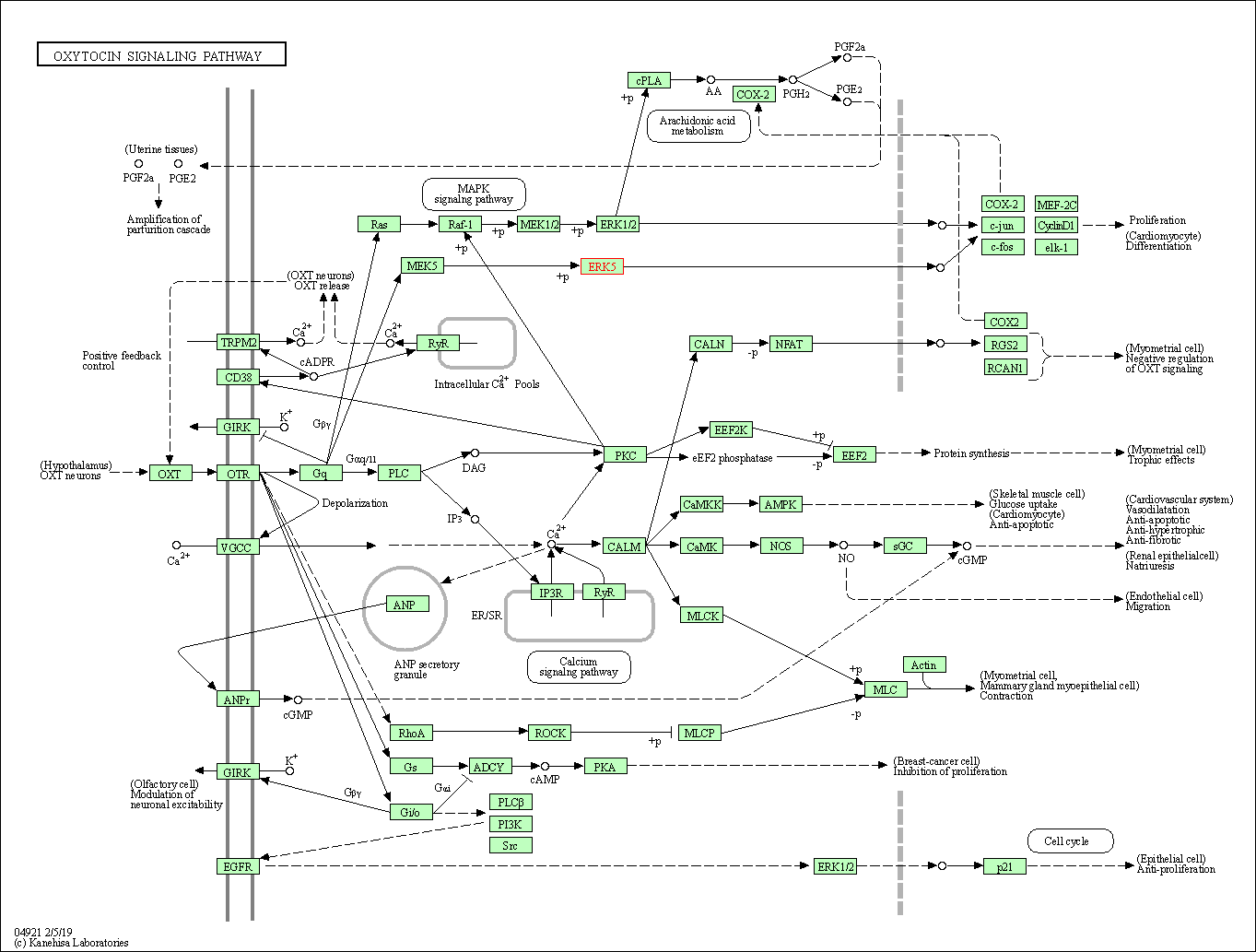
|
| Class: Organismal Systems => Endocrine system | Pathway Hierarchy | ||
| Click to Show/Hide the Information of Affiliated Human Pathways | |||
| Degree | 6 | Degree centrality | 6.45E-04 | Betweenness centrality | 1.03E-04 |
|---|---|---|---|---|---|
| Closeness centrality | 1.95E-01 | Radiality | 1.33E+01 | Clustering coefficient | 6.67E-02 |
| Neighborhood connectivity | 9.67E+00 | Topological coefficient | 2.65E-01 | Eccentricity | 12 |
| Download | Click to Download the Full PPI Network of This Target | ||||
| Chemical Structure based Activity Landscape of Target | Top |
|---|---|
| Drug Property Profile of Target | Top | |
|---|---|---|
| (1) Molecular Weight (mw) based Drug Clustering | (2) Octanol/Water Partition Coefficient (xlogp) based Drug Clustering | |
|
|
||
| (3) Hydrogen Bond Donor Count (hbonddonor) based Drug Clustering | (4) Hydrogen Bond Acceptor Count (hbondacc) based Drug Clustering | |
|
|
||
| (5) Rotatable Bond Count (rotbonds) based Drug Clustering | (6) Topological Polar Surface Area (polararea) based Drug Clustering | |
|
|
||
| "RO5" indicates the cutoff set by lipinski's rule of five; "D123AB" colored in GREEN denotes the no violation of any cutoff in lipinski's rule of five; "D123AB" colored in PURPLE refers to the violation of only one cutoff in lipinski's rule of five; "D123AB" colored in BLACK represents the violation of more than one cutoffs in lipinski's rule of five | ||
| Target Poor or Non Binders | Top | |||||
|---|---|---|---|---|---|---|
| Target Poor or Non Binders | ||||||
| Target Regulators | Top | |||||
|---|---|---|---|---|---|---|
| Target-regulating microRNAs | ||||||
| Target-interacting Proteins | ||||||
| References | Top | |||||
|---|---|---|---|---|---|---|
| REF 1 | BET inhibitors in cancer therapeutics: a patent review.Expert Opin Ther Pat. 2016;26(4):505-22. | |||||
| REF 2 | Pharmacological inhibition of BMK1 suppresses tumor growth through promyelocytic leukemia protein. Cancer Cell. 2010 Sep 14;18(3):258-67. | |||||
| REF 3 | Structural mechanism for the specific assembly and activation of the extracellular signal regulated kinase 5 (ERK5) module. J Biol Chem. 2013 Mar 22;288(12):8596-8609. | |||||
| REF 4 | Discovery of a novel allosteric inhibitor-binding site in ERK5: comparison with the canonical kinase hinge ATP-binding site. Acta Crystallogr D Struct Biol. 2016 May;72(Pt 5):682-93. | |||||
If You Find Any Error in Data or Bug in Web Service, Please Kindly Report It to Dr. Zhou and Dr. Zhang.

